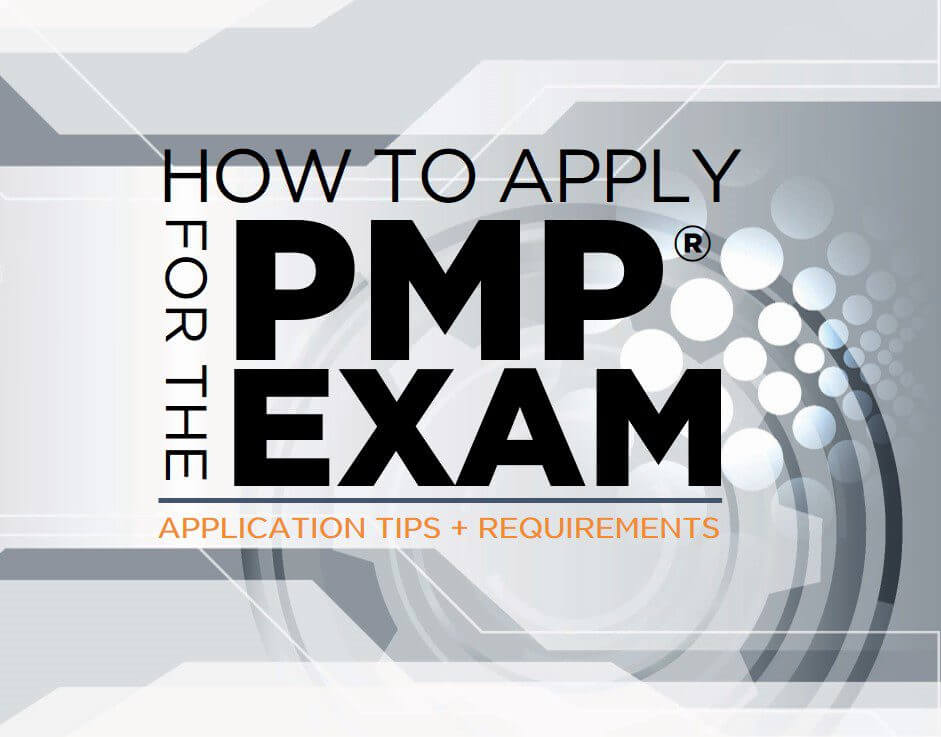Project Management
How to Apply for the PMP® Exam : Application Tips and Requirements

How to Apply for the PMP® Exam : Application Tips and Requirements
Are you ready to begin the journey to becoming a certified Project Management Professional?
Before you can take the PMP® certification exam, you’ll need to complete an application so that the Project Management Institute (PMI) can validate your years of experience and education as a project manager. The application process can feel overwhelming, so we’ve put together a guide that takes an in-depth look at each step and includes helpful tips to make the process a little less daunting.
Here’s a quick overview of the steps in applying for the PMP® exam:
Step 1: Create a PMI.org account.
Step 2: Complete and submit the online application.
Step 3: Wait for confirmation of completeness.
Step 4: Complete audit materials if you are audited…
Step 5: Pay the credential fee.
Step 6: Prepare for the exam.
Step 7: Schedule (and pass) the exam!
This guide will walk you through each of these steps so that you are fully prepared to apply for and earn your credential!
Before You Apply
Before you apply for the exam, you’ll want to ensure you meet the eligibility requirements. The eligibility requirements vary based on your level of education.
If you have a four-year degree, you’ll need:
- 36 months of non-overlapping professional experience leading projects
- AND 35 hours of project management training
If you have a high school diploma or associate degree, you’ll need:
- 60 months of non-overlapping professional experience leading projects
- AND 35 hours of project management training
To ensure your experience counts, it is vitally important that:
- Your project management experience represents professional project work experience only. You cannot include personal projects like planning your personal wedding, conducting academic research for a degree-granting program, creating a newsletter, or a home improvement project.
- Your project experience is not actually an operational experience. A project is a temporary endeavor that produces one or more unique deliverables. In other words, projects should not include any routine, operational, or administrative tasks and responsibilities.
- You were performing the role of a project manager rather than a contributor or team member. The typical role of a project manager is outlined in the PMI Exam Content Outline. Read the list of tasks and validate that the role you served on the project generally aligns with those listed.
- Your project experience is non-overlapping. This means that, for each month in which you worked on overlapping projects, you can only count the time spent on ONE of those projects toward fulfilling your eligibility requirements.
To ensure your project management training counts:
Be sure the course(s) you took includes content that addresses project management learning objectives. You can satisfy the education requirements by demonstrating the successful completion of courses, workshops, and training sessions offered by one or more of the following types of education providers:
- PMI Authorized Training Partners (ATPs)
- PMI Chapters
- Employer or Company-Sponsored Programs
- Training Companies or Consultants
- Distance-Learning Companies
- University/College Academic and Continuing Education Programs
Note: you cannot include PMI Chapter Meetings or self-directed learning as educational hours.
How to Apply for the PMP® Exam
Step 1: Create a PMI.org account.
To begin your application, set up an account at PMI.org. You do NOT have to become a member of PMI to earn your credential, but it’s a good idea. The cost of the exam is $405 for members but $555 for non-members. PMI membership is $129/year, so the discount makes up for the cost of membership. Membership affords you access to free electronic copies of the PMBOK® Guide, Salary Report, and other guides and standards published by PMI. Joining your local chapter usually requires paying an additional small annual fee. You can become a PMI global member without joining your local chapter.
Step 2: Complete and submit the online application.
The application form can be accessed online once you’ve logged into your account. The site will ask you to provide information about yourself and your eligibility. Don’t worry,…if you don’t have time to complete the whole thing at once, you can save your progress and continue later. Here are the main sections you’ll need to complete:
Education Section
In this section, you’ll first need to provide your academic information, including:
- The highest level of education achieved
- Name of Institution
- Field of Study
- Country of Institution
- Years Attended
You’ll also need to enter your professional education information to prove you have attained the necessary 35 hours of project management training. You will need to list the following for every course that you are counting toward the 35-hour requirement:
- Course Title
- Provider Name
- Course Dates
- Qualifying Hours
Experience Section
In this section, you’ll list your project experiences, starting with your most recent project. PMI will calculate your total months from Start Date to Finish Date to ensure no overlaps. For each project, you’ll need to provide:
- Project Title
- Organization
- Job Title
- Functional Reporting Area
- Organization Primary Focus (i.e., Industry)
- Approach/Methodology (e.g., Traditional, Agile, or Hybrid)
- Project Team Size
- Project Budget
- Project Dates (including whether or not the project is in progress)
- Project Description (200-500 words)
Your project description should summarize your experience on the project, including the project objective, outcome, your role on the project, and your responsibilities or deliverables. It is a good idea to focus the description primarily on what you did on the project (your project management experience) vs. the scope of the project itself. Ensure that the responsibilities you list generally align with the responsibilities of a project manager, as described in the Exam Content Outline.
Exam Details
In this section, you’ll put some basic contact information about yourself, including how you want your name to appear on your PMP® certificate once it is earned. You’ll also be given a chance to note where you intend to take this exam and any exam accommodations you may require.
Step 3: Wait for Confirmation of Completeness.
PMI may take up to five days to verify that your application is complete and provide approval for you to pay for and schedule your exam. Alternatively, during the same time period, you may receive notification that you’ve been audited. If that occurs, see Step 4.
Step 4: If You Are Audited…
Audits are primarily random. If you’re selected for an audit, you’ll be notified by email before the certification fee payment. During an audit, you’ll be asked to submit supporting documentation like:
- Copies of your diploma (or global equivalent)
- Signatures from your supervisor(s) or manager(s) from the projects recorded in the experience section
- Copies of certificates and/or letters from the training institutes for each course recorded on the application to meet the required contact hours of project management education
You have 90 days to send your audit materials. Once received, PMI will process those materials within 5-7 days.
Step 5: Pay the Credential Fee.
The next step is to pay your credential fee. This can be done online.
Some companies will offer to pay for PMP Prep training or your exam fee. Use this Training Request Template to draft your letter.
Step 6: Prepare For the Exam.
The 2021 PMP exam is challenging. Most people find that they need to use multiple strategies to prepare for the exam (prep books, exam simulation software, and/or formal exam prep training.)
Here are a few guidelines we’ve found to be most helpful when preparing for the exam:
- Seek resources and training from a PMI® Premier Authorized Training Partner. These companies are fully approved to teach the official, PMI-developed materials so that you can be confident that you’re getting everything you need to prepare for the exam. Premier ATPs have additional access to real cloned questions from the PMI exam, so they are best positioned to help you prepare for test day.
- Spend as much time completing practice questions and exams as you do studying the content. Practicing REAL exam questions helps you think like the Test Makers, and helps you choose the correct answer (even when multiple choices seem right!) Additionally, going over exam questions also helps you simulate the “pressure” that you are likely to experience on test day, and learn to thrive on it.
- Choose an instructor you like! PMP Prep courses can be grueling. There is a lot of content to cover, so make sure that your instructor is engaging, likable, experienced, and highly gifted at explaining concepts in multiple ways. If possible, read about your instructor upfront or email them to ask them questions about the class before purchasing.
Want a good place to start? The Persimmon Group’s 5-week program is designed especially with busy professionals in mind. It includes all the support you need to pass the exam the first time, including access to 1000+ exceptionally realistic PMP exam questions.
Contact The Persimmon Group and talk to one of our Project Management Professionals. We are happy to help!
Step 7: Schedule (and Pass) Your Exam!
The PMP® exam can be taken online or at a testing site near you. The exam is a 180-question, multiple-choice exam. Regardless of how experienced you are, you should still prepare rigorously for the exam. Successful candidates typically use multiple study aids, including courses and study groups.
Once you take your exam, you’ll immediately receive your score. In addition to the overall pass/fail status, important diagnostic information on your performance is provided for each domain. Within the results, the test report will show you one of four performance levels by domain: Above Target, Target, Below Target, and Needs Improvement.
You can take the exam up to 3 times during the year after your application approval. Your certification becomes official the day you pass the exam!

Download our FREE guide to PMP certification, including expert answers to your top questions AND step-by-step instructions to complete your application.
The Project Management Professional (PMP), The PMI Registered Education Provider logo, and PMBOK are registered marks of the Project Management Institute, Inc.
insights categories
get newsletter updates
Executive coaching & development
The Persimmon Group
The Persimmon Group is a multi-disciplined management consulting and learning organization that helps business leaders solve complex business problems, improve efficiency, empower teams and implement long-term sustainable improvements.
Sign Up For Our Newsletter
Practical strategies to help you thrive in Leadership, Project Management, and more.








